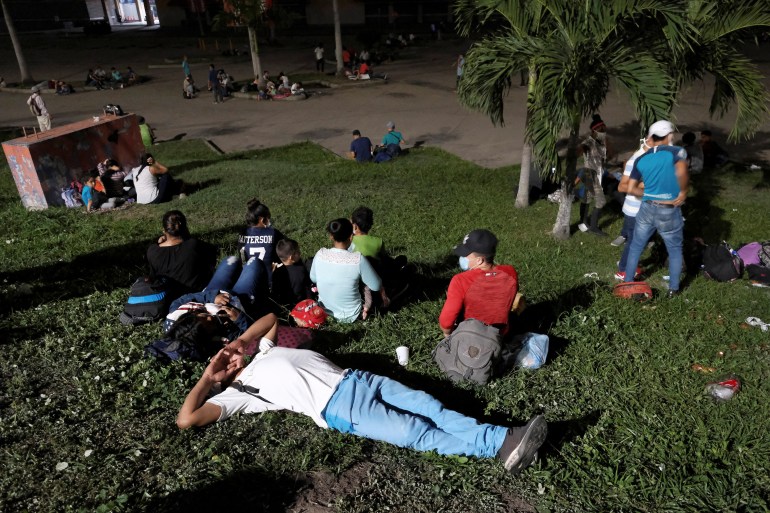Migrant caravan sets out for the US amid COVID-19 concerns
Thousands of Hondurans begin their journey to the US as Honduras reels from the pandemic’s economic effect.

The first Hondurans hoping to reach the United States arrived at the Guatemala border on foot on Thursday morning as part of a newly-formed caravan, testing the newly reopened frontier that had been shut thanks to the coronavirus pandemic a month before the US presidential elections.
Guatemalan authorities reported more than 1,000 people had crossed the border from Honduras without proper documentation on their path to the US.
Keep reading
list of 4 itemsWhy Egypt backed South Africa’s genocide case against Israel in the ICJ
As South Africa votes, Zimbabwean migrants, smugglers anxious about future
EU signs off on sweeping migration overhaul ahead of elections
Edwin Omar Molino, a 17-year-old from Cortes, said he was leaving Honduras because he could not find work. He blamed President Juan Orlando Hernandez for running the country into the ground.
“Even when you want to find a job, there aren’t any. That’s why we leave our country,” Molino told the Associated Press news agency.
“There’s the pandemic, and it scares me,” he added. But he said he would not be able to help his family get ahead without taking the risk.
Difficult journey
Central Americans began travelling in large groups in recent years, seeking safety in numbers and in some cases avoiding the cost of smugglers. Calls for a new caravan to leave on October 1 had circulated for weeks on social media, and unconfirmed posts on social media appear to show groups travelling through Honduras towards the border.
The odds of a large migrant caravan reaching the US border, already low, have grown increasingly slim over the past year. Under pressure from the US, Mexico deployed its National Guard and more immigration agents to break up attempted caravans last year.
They dispersed large groups of migrants attempting to travel together in southern Mexico. Actually crossing into the US legally is virtually impossible now with the pandemic, and entering without documents is as difficult as ever.

The departure of the new group was reminiscent of a migrant caravan that formed two years ago shortly before US midterm elections. It became a hot issue in the campaign, driving anti-immigrant rhetoric.
While the caravans draw attention, they account for a small fraction of the daily migration flow by small groups that pass unnoticed through Central America and Mexico.
The group that arrived at the Guatemala border on Thursday had set out walking the previous night from San Pedro Sula, jumping the gun on their own scheduled departure.
Guatemalan immigration authorities said on Thursday more than 500 were being processed at the Corinto crossing, but most lacked required identification documents. Authorities planned to register those entering the country and offer a voluntary assisted return to those willing to turn back.
AP journalists reported seeing others crossing the border illegally near the formal crossing. A regional agreement allows citizens of Honduras to transit through Guatemala.
Guatemalan officials were requiring the migrants to provide documents showing a negative COVID-19 test – even though last week they said they would not require a test for those spending less than 72 hours in the country. Dozens of Guatemalan police and soldiers maintained order.
Those who walked down dark streets on Wednesday night away from San Pedro Sula’s bus station carried small knapsacks, and many wore masks. They appeared to be mostly young men, though there were the occasional small children being pushed in strollers.
Governments throughout the region made it known they were watching on Wednesday. Mexico’s immigration agency said in a statement that would enforce “safe, orderly and legal” migration and not do anything to promote the formation of a caravan.
The US embassy in Honduras said on Twitter on Wednesday migration to the US was more difficult than ever right now – and more dangerous because of the coronavirus.
Ahora más que nunca, es más difícil cruzar la frontera de Estados Unidos de manera ilegal. El viaje se ha hecho aún más peligroso, dada la actual pandemia global de #COVID19.#NoExpongasTusHijos#SuFuturoEstáAquí pic.twitter.com/8KcKBHcee0
— U.S. Embassy Honduras (@usembassyhn) October 1, 2020
Translation: Now more than ever, it is more difficult to illegally cross the US border. The journey is made even more dangerous by the current global COVID-19 pandemic.
But the factors driving migrants to leave Central America have not eased during the pandemic. As economies have suffered, there are ever fewer jobs available, and the struggle for families to put food on the table has worsened. Some migrants also cited the ever-present high rate of crime.
Job losses
The UN’s International Labor Organization (ILO) on Wednesday said at least 34 million jobs have been lost in Latin America due to the pandemic.
The ILO lists Latin America and the Caribbean as the worst-hit region in the world in terms of lost working hours, with a drop of 20.9 percent in the first three quarters of the year.
The flow of migrants north from Central America had slowed dramatically during the pandemic as countries throughout the region closed their borders. Most migrant shelters along the principal routes closed their doors to new arrivals as they tried to keep the virus from spreading to vulnerable populations.
Mexico and the US deported hundreds of migrants back to their home countries in an attempt to empty detention centres.
The US government effectively shut down the asylum system at its southern border during the pandemic.
Mexico tried to bus asylum seekers stuck at its northern border to other parts of the country and back to their home countries.
Mexico has typically offered migrants the opportunity to seek asylum there, but many have their minds set on the US. Migrants are also likely to find it more difficult to find work in Mexico now as the economy is expected to contract 10 percent this year due to the effect of the pandemic.